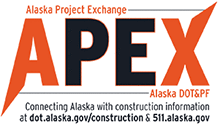HSIP: Nordale Road / Peede Road Intersection Safety Improvements
IRIS # NFHWY00948, Federal Project # 0653 (009)

Nordale Road / Peede Road project location
Intro
We are initiating a Highway Safety Improvement Program (HSIP) funded project at the intersection of Nordale Road and Peede Road with the goal of improving safety and reducing crashes..
Project Schedule
The project team is currently working on preliminary design concepts and environmental documentation. Currently there are no ROW impacts anticipated for this project. Construction is anticipated to begin in 2028, depending on funding.
Purpose
Nordale Road serves as the only connection across the Chena River from Badger Road to Chena Hot Springs Road. Peede Road, meanwhile, is a commonly used short cut from Badger Road to Nordale Road and the two-way stop controlled intersection of Peede Road and Nordale Road has accumulated a history of vehicle crashes. The purpose of this project is to improve safety and reduce crashes at this intersection. The project team will develop preliminary concepts for the intersection, in preparation of a Design Study Report (approximately 35% design effort).
Public Involvement
Two open house style public meetings will be held to inform the public of the current design plans, share project timelines, and receive public input.
State of Alaska Policy
The Federal Highway Administration and the State of Alaska have a “Roundabouts First” policy that requires us to consider a roundabout before other potential solutions like a traffic signal.
Why are roundabouts safer than a signal or stop sign?
Fewer opportunities for crashes: In a traditional four-way intersection, there are more points where vehicle paths conflict with each other. For example, a vehicle turning left could be in conflict with on-coming traffic. In a roundabout, there are fewer opportunities for conflict because vehicles are flowing in the same direction around the roundabout.
Less-severe crashes: The types of crashes that occur in a traditional four-way intersection include high-speed t-bone and head-on crashes that are more likely to be serious. Crashes that occur in roundabouts tend to happen at slower speeds and be side-angle crashes, which are typically less severe.
Visit our roundabouts website to learn more.

Use DOT&PF’s Alaska Project Exchange tools to learn more about all of DOT&PF’s active construction projects statewide!
Want to know how construction will impact road traffic? Visit 511.alaska.gov
Want to dig into the details about projects across the state? Visit dot.alaska.gov/construction
If you have questions or comments about these projects, please contact:
Ethan E. Graetz, P.E.
Engineering Manager,
DOT&PF
2301 Peger Rd Fairbanks, AK 99709
![]() (907) 451-2281 or
(907) 451-2281 or
ethan.graetz@alaska.gov
For individuals requiring TTY communications, please contact Alaska Relay at 7-1-1 or 1-800-770-8973.
The environmental review, consultation, and other actions required by applicable Federal environmental laws for this project are being, or have been, carried out by DOT&PF pursuant to 23 U.S.C. 327 and a Memorandum of Understanding dated April 13, 2023, and executed by FHWA and DOT&PF.
PLEASE NOTE: Adobe Acrobat PDF files require a free viewer available directly from Adobe.
